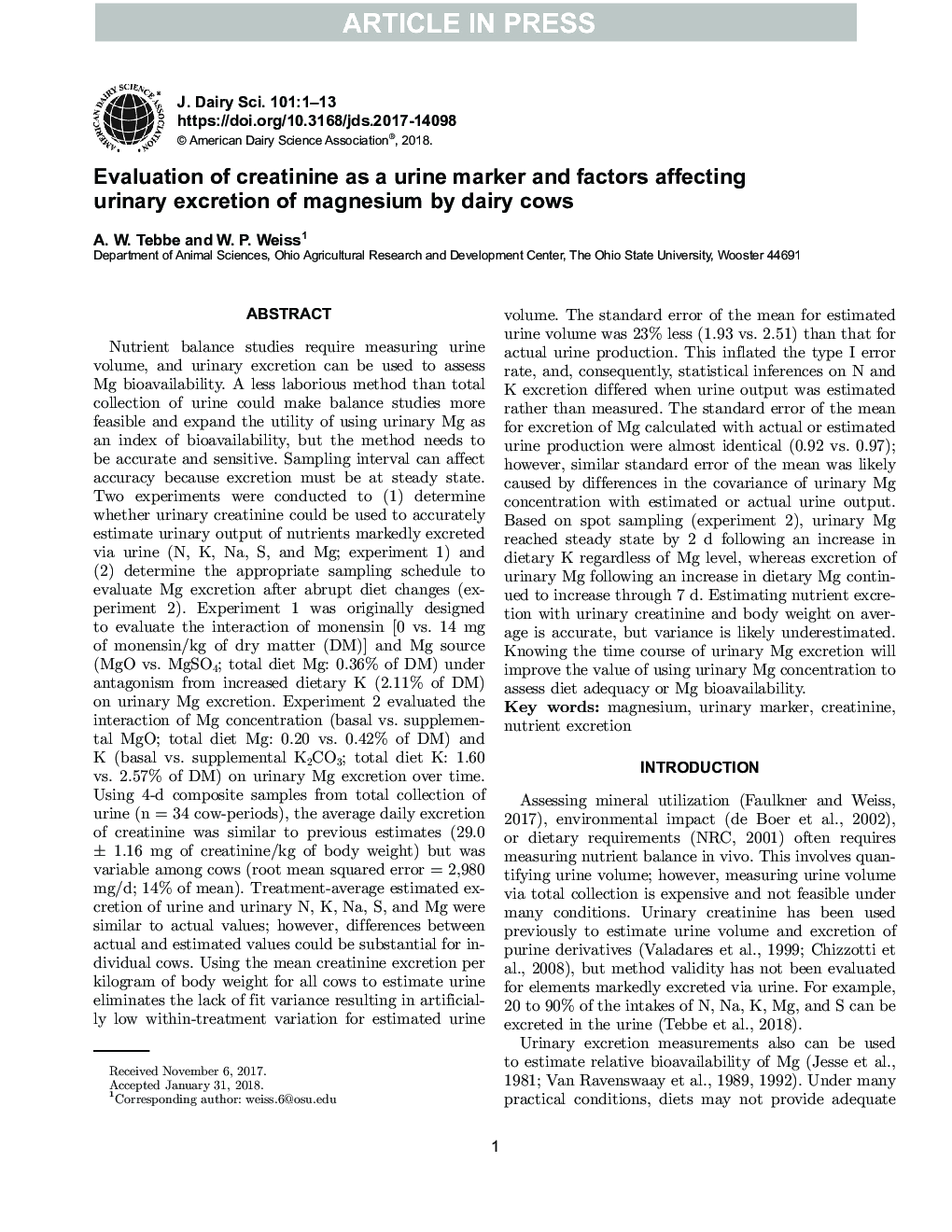| کد مقاله | کد نشریه | سال انتشار | مقاله انگلیسی | نسخه تمام متن |
|---|---|---|---|---|
| 8501097 | 1553839 | 2018 | 13 صفحه PDF | دانلود رایگان |
عنوان انگلیسی مقاله ISI
Evaluation of creatinine as a urine marker and factors affecting urinary excretion of magnesium by dairy cows
ترجمه فارسی عنوان
بررسی کراتینین به عنوان نشانگر ادرار و عوامل موثر بر دفع ادراری منیزیم توسط گاوهای شیری
دانلود مقاله + سفارش ترجمه
دانلود مقاله ISI انگلیسی
رایگان برای ایرانیان
کلمات کلیدی
منیزیم، نشانگر ادرار، کراتینین دفع مواد مغذی،
موضوعات مرتبط
علوم زیستی و بیوفناوری
علوم کشاورزی و بیولوژیک
علوم دامی و جانورشناسی
چکیده انگلیسی
Nutrient balance studies require measuring urine volume, and urinary excretion can be used to assess Mg bioavailability. A less laborious method than total collection of urine could make balance studies more feasible and expand the utility of using urinary Mg as an index of bioavailability, but the method needs to be accurate and sensitive. Sampling interval can affect accuracy because excretion must be at steady state. Two experiments were conducted to (1) determine whether urinary creatinine could be used to accurately estimate urinary output of nutrients markedly excreted via urine (N, K, Na, S, and Mg; experiment 1) and (2) determine the appropriate sampling schedule to evaluate Mg excretion after abrupt diet changes (experiment 2). Experiment 1 was originally designed to evaluate the interaction of monensin [0 vs. 14 mg of monensin/kg of dry matter (DM)] and Mg source (MgO vs. MgSO4; total diet Mg: 0.36% of DM) under antagonism from increased dietary K (2.11% of DM) on urinary Mg excretion. Experiment 2 evaluated the interaction of Mg concentration (basal vs. supplemental MgO; total diet Mg: 0.20 vs. 0.42% of DM) and K (basal vs. supplemental K2CO3; total diet K: 1.60 vs. 2.57% of DM) on urinary Mg excretion over time. Using 4-d composite samples from total collection of urine (n = 34 cow-periods), the average daily excretion of creatinine was similar to previous estimates (29.0 ± 1.16 mg of creatinine/kg of body weight) but was variable among cows (root mean squared error = 2,980 mg/d; 14% of mean). Treatment-average estimated excretion of urine and urinary N, K, Na, S, and Mg were similar to actual values; however, differences between actual and estimated values could be substantial for individual cows. Using the mean creatinine excretion per kilogram of body weight for all cows to estimate urine eliminates the lack of fit variance resulting in artificially low within-treatment variation for estimated urine volume. The standard error of the mean for estimated urine volume was 23% less (1.93 vs. 2.51) than that for actual urine production. This inflated the type I error rate, and, consequently, statistical inferences on N and K excretion differed when urine output was estimated rather than measured. The standard error of the mean for excretion of Mg calculated with actual or estimated urine production were almost identical (0.92 vs. 0.97); however, similar standard error of the mean was likely caused by differences in the covariance of urinary Mg concentration with estimated or actual urine output. Based on spot sampling (experiment 2), urinary Mg reached steady state by 2 d following an increase in dietary K regardless of Mg level, whereas excretion of urinary Mg following an increase in dietary Mg continued to increase through 7 d. Estimating nutrient excretion with urinary creatinine and body weight on average is accurate, but variance is likely underestimated. Knowing the time course of urinary Mg excretion will improve the value of using urinary Mg concentration to assess diet adequacy or Mg bioavailability.
ناشر
Database: Elsevier - ScienceDirect (ساینس دایرکت)
Journal: Journal of Dairy Science - Volume 101, Issue 6, June 2018, Pages 5020-5032
Journal: Journal of Dairy Science - Volume 101, Issue 6, June 2018, Pages 5020-5032
نویسندگان
A.W. Tebbe, W.P. Weiss,
